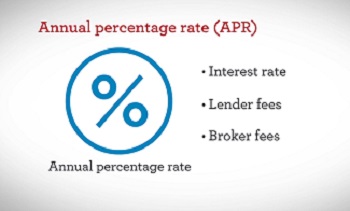Consider the Annual Percentage Rate (APR)

According to Realty Biz News, “Mortgage rates at their current record lows offer some serious savings for both home buyers and people looking to refinance. But experts say a low mortgage rate is only one part of the equation, as people also need to consider the annual percentage rate (APR) of the loan to take into account other costs such as upfront fees.
Consider the Annual Percentage Rate (APR)
The financial website NextAdvisor writes, “Once additional fees have been factored in, a buyer with a 30-year fixed-rate mortgage with 2.9% annual interest may be paying at a rate of 3.1%. Buyers need to be aware of this, experts say.
Linda Knowlton, president of the Florida Association of Mortgage Professionals, told NextAdvisor that the annual percentage rate is confusing for many people. “It’s the broader measure of the cost of borrowing money.”
What is the Difference Between Interest Rate and APR?
What is the difference between the advertised interest rate and APR?” the couple asked. “I know our realtor explained it, and so did our lender at closing, but we really don’t understand it?”
Look at it this way: there is the advertised rate (the interest rate) to borrow money to buy a house and the real rate (the APR). There are many costs associated with taking out a mortgage. These include:
Consider the Annual Percentage Rate (APR)
The interest rate The interest rate is the cost of borrowing the principal loan amount. It can be variable or fixed, but it’s always expressed as a percentage. For example, if you borrow $200,000 at 4%, you will pay $8,000 in the first year.
Annual percentage rate (APR) The APR is a broader measure of the cost of your mortgage because it reflects the interest rate and other costs such as broker fees, discount points, and some closing costs. The APR, like the interest rate, is expressed as a percentage.
Under the Truth in Lending Act, lenders must disclose the APR to borrowers.
“The main difference is that the interest rate calculates what your actual monthly payment will be,” says Sean O. McGeehan, a loan officer in Homer Glen, Illinois. “The APR calculates the total cost of the loan. A consumer can use one or both to make apples-to-apples comparisons when shopping for loans.” The APR will always be equal to or higher than the interest rate.
Here’s the tricky part
The APR assumes the borrower will stay with that loan for the entire term of the loan. Gloria Shulman, founder of Centek Capital Group in Beverly Hills, California, writes, “The key when looking at APR, as it is for many loan decisions, is time horizon. It’s the most important question borrowers need to ask themselves before looking for a home and the mortgage that best fits their current and projected financial and family situations.”
Tip from CFPB
Take care when comparing the APRs of adjustable-rate loans
For adjustable-rate loans, the APR does not reflect the maximum interest rate of the loan. Be careful when comparing the APRs of fixed-rate loans with adjustable-rate mortgages or among different adjustable-rate loans. Don’t look at the APR alone in determining what loan makes the most sense for your circumstances.
Does it Pay to Shop for the Best Deal?
Yes! The difference between $1061 per month and $1095 per month is $12,240 in 30 years. However, it is doubtful that you will stay in the house for 30 years or go without some change in your mortgage, which will alter all the calculations.
Ask for FREE information about How to Sell Your House Fast.
Terra Firma Property Solutions, LLC is a professional, full-service real estate solutions firm.
We buy and sell properties throughout the greater Kansas City area. We specialize in buying distressed homes, then renovating and reselling them to home buyers and landlords. Terra Firma Property Solutions: excited to be part of the economic rejuvenation of Kansas City and its surrounding areas.
Call us today at (816) 866.0566
